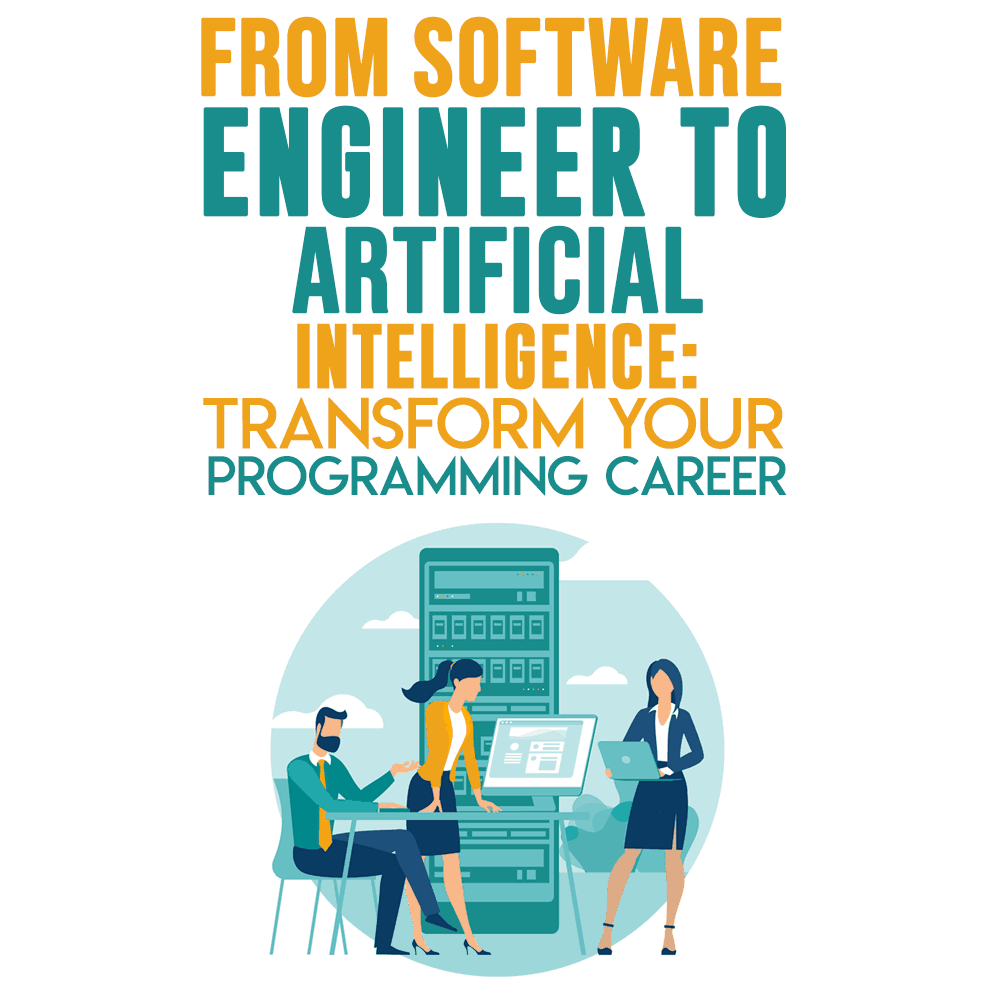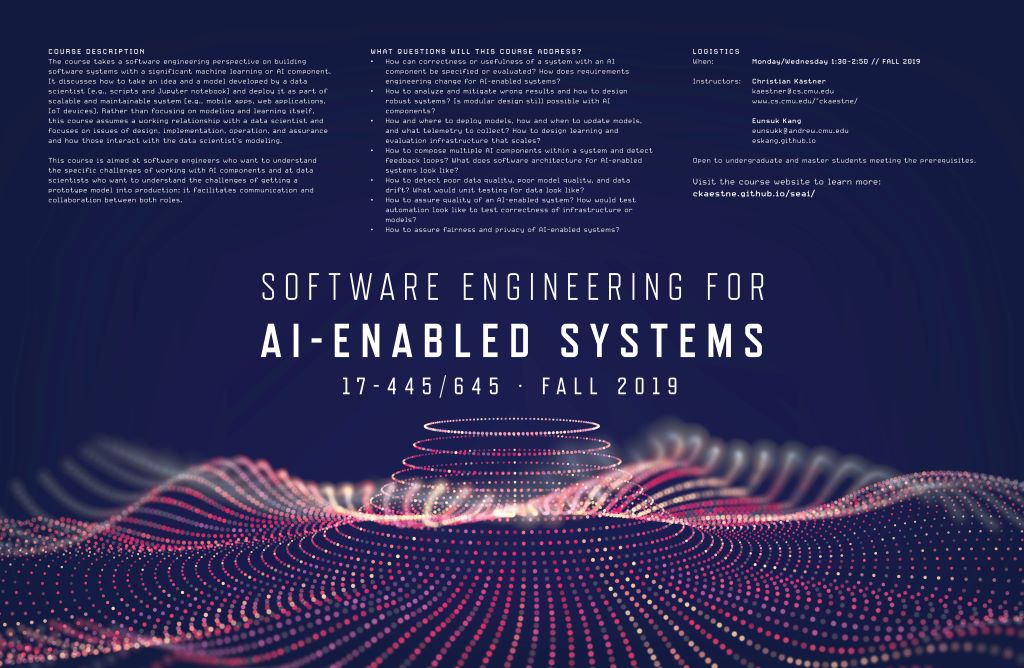All Categories
Featured
Table of Contents
You most likely know Santiago from his Twitter. On Twitter, every day, he shares a lot of practical things regarding equipment discovering. Alexey: Before we go right into our major subject of relocating from software design to machine learning, possibly we can start with your history.
I began as a software designer. I mosted likely to university, got a computer system science degree, and I began building software application. I think it was 2015 when I decided to go for a Master's in computer technology. Back then, I had no concept regarding artificial intelligence. I really did not have any kind of rate of interest in it.
I recognize you have actually been utilizing the term "transitioning from software design to artificial intelligence". I such as the term "including to my capability the artificial intelligence skills" a lot more because I assume if you're a software application designer, you are currently providing a great deal of value. By including artificial intelligence now, you're enhancing the effect that you can have on the market.
Alexey: This comes back to one of your tweets or maybe it was from your training course when you compare two techniques to discovering. In this instance, it was some issue from Kaggle concerning this Titanic dataset, and you simply find out just how to fix this problem utilizing a particular device, like choice trees from SciKit Learn.
Getting My How I’d Learn Machine Learning In 2024 (If I Were Starting ... To Work
You first learn math, or linear algebra, calculus. When you know the math, you go to maker knowing theory and you learn the concept.
If I have an electrical outlet below that I need changing, I do not want to most likely to college, invest four years recognizing the mathematics behind electricity and the physics and all of that, just to alter an electrical outlet. I would certainly rather begin with the electrical outlet and locate a YouTube video that helps me go via the problem.
Poor example. You obtain the concept? (27:22) Santiago: I really like the concept of starting with a problem, trying to toss out what I know as much as that problem and recognize why it does not function. Grab the devices that I need to fix that problem and start excavating deeper and much deeper and much deeper from that point on.
That's what I normally recommend. Alexey: Perhaps we can chat a little bit concerning learning resources. You discussed in Kaggle there is an intro tutorial, where you can get and find out just how to choose trees. At the start, before we started this meeting, you pointed out a pair of publications as well.
The only need for that program is that you know a little bit of Python. If you go to my profile, the tweet that's going to be on the top, the one that says "pinned tweet".
The Basic Principles Of Online Machine Learning Engineering & Ai Bootcamp

Even if you're not a designer, you can start with Python and work your way to more machine knowing. This roadmap is concentrated on Coursera, which is a system that I really, actually like. You can examine every one of the programs free of cost or you can pay for the Coursera membership to get certifications if you intend to.
That's what I would certainly do. Alexey: This comes back to among your tweets or possibly it was from your training course when you contrast two strategies to learning. One approach is the problem based technique, which you simply discussed. You locate a problem. In this instance, it was some issue from Kaggle regarding this Titanic dataset, and you simply find out just how to address this trouble utilizing a specific device, like decision trees from SciKit Learn.

You first learn mathematics, or direct algebra, calculus. When you know the math, you go to equipment understanding concept and you discover the concept.
If I have an electrical outlet right here that I need changing, I don't desire to go to university, invest 4 years comprehending the mathematics behind electrical energy and the physics and all of that, simply to alter an outlet. I would rather start with the electrical outlet and discover a YouTube video that assists me go with the problem.
Poor example. You obtain the concept? (27:22) Santiago: I really like the concept of beginning with an issue, attempting to throw out what I know approximately that trouble and recognize why it does not function. After that order the tools that I need to address that problem and start excavating much deeper and much deeper and much deeper from that factor on.
To make sure that's what I normally recommend. Alexey: Possibly we can chat a little bit concerning learning sources. You stated in Kaggle there is an intro tutorial, where you can get and find out how to make choice trees. At the start, before we began this meeting, you pointed out a number of books also.
Excitement About Master's Study Tracks - Duke Electrical & Computer ...
The only demand for that training course is that you recognize a little bit of Python. If you go to my profile, the tweet that's going to be on the top, the one that claims "pinned tweet".
Also if you're not a designer, you can begin with Python and function your method to more equipment discovering. This roadmap is concentrated on Coursera, which is a platform that I actually, truly like. You can examine every one of the training courses for free or you can pay for the Coursera registration to get certificates if you desire to.
How To Become A Machine Learning Engineer [2022] for Dummies
Alexey: This comes back to one of your tweets or possibly it was from your program when you compare 2 methods to understanding. In this instance, it was some problem from Kaggle regarding this Titanic dataset, and you just discover how to resolve this issue utilizing a details tool, like decision trees from SciKit Learn.

You first discover math, or direct algebra, calculus. After that when you understand the math, you go to artificial intelligence concept and you discover the theory. After that 4 years later on, you finally pertain to applications, "Okay, just how do I make use of all these four years of math to solve this Titanic issue?" ? So in the former, you kind of conserve yourself a long time, I think.
If I have an electric outlet right here that I need replacing, I don't want to most likely to university, invest 4 years comprehending the math behind electrical power and the physics and all of that, simply to change an electrical outlet. I would rather start with the electrical outlet and find a YouTube video that assists me undergo the trouble.
Poor example. You get the idea? (27:22) Santiago: I really like the idea of starting with a problem, attempting to toss out what I understand approximately that trouble and recognize why it does not function. Order the tools that I require to solve that problem and begin excavating much deeper and deeper and much deeper from that point on.
Alexey: Perhaps we can speak a bit regarding learning sources. You stated in Kaggle there is an introduction tutorial, where you can get and discover exactly how to make decision trees.
What Does No Code Ai And Machine Learning: Building Data Science ... Mean?
The only need for that course is that you recognize a little bit of Python. If you're a developer, that's a terrific starting point. (38:48) Santiago: If you're not a designer, then I do have a pin on my Twitter account. If you go to my account, the tweet that's going to get on the top, the one that claims "pinned tweet".
Even if you're not a designer, you can begin with Python and work your means to even more artificial intelligence. This roadmap is focused on Coursera, which is a platform that I truly, really like. You can examine all of the training courses completely free or you can spend for the Coursera subscription to get certifications if you desire to.
That's what I would do. Alexey: This returns to one of your tweets or perhaps it was from your training course when you contrast two techniques to knowing. One technique is the trouble based strategy, which you simply discussed. You find a trouble. In this situation, it was some issue from Kaggle about this Titanic dataset, and you simply learn exactly how to resolve this trouble using a specific tool, like choice trees from SciKit Learn.
You first find out mathematics, or straight algebra, calculus. Then when you know the math, you most likely to artificial intelligence concept and you find out the theory. After that 4 years later, you finally come to applications, "Okay, just how do I utilize all these four years of mathematics to fix this Titanic issue?" Right? In the former, you kind of save yourself some time, I believe.
Unknown Facts About Untitled
If I have an electric outlet here that I require replacing, I do not wish to go to university, invest 4 years understanding the mathematics behind electrical power and the physics and all of that, simply to change an outlet. I prefer to begin with the electrical outlet and find a YouTube video clip that helps me go via the trouble.
Santiago: I actually like the idea of beginning with a problem, attempting to throw out what I recognize up to that problem and comprehend why it does not function. Get hold of the tools that I need to solve that trouble and start digging much deeper and deeper and much deeper from that point on.

Alexey: Maybe we can talk a bit concerning discovering sources. You discussed in Kaggle there is an introduction tutorial, where you can get and discover exactly how to make decision trees.
The only need for that training course is that you know a little bit of Python. If you go to my account, the tweet that's going to be on the top, the one that claims "pinned tweet".
Even if you're not a developer, you can start with Python and work your way to more machine knowing. This roadmap is focused on Coursera, which is a platform that I actually, truly like. You can investigate all of the training courses free of cost or you can pay for the Coursera subscription to get certifications if you wish to.
Latest Posts
Back-end Engineering Interview Guide – What To Expect
Google Software Engineer Interview Process – What To Expect In 2025
How To Prepare For Amazon’s Software Engineer Interview